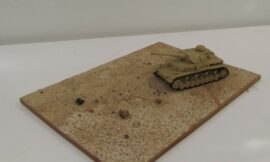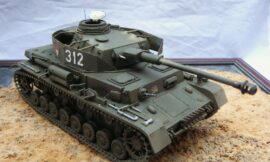The Jagdtiger, officially known as the Panzerjäger Tiger Ausf. B, was the heaviest tank destroyer fielded by Germany during World War II. It was designed and produced in response to the increasing armor protection of Allied tanks, particularly Soviet heavy tanks like the IS-2. The Jagdtiger combined the chassis of the Tiger II tank with a massive 12.8 cm Pak 44 L/55 gun, making it one of the most powerful armored vehicles of the war.
Development and Design
Development of the Jagdtiger began in 1943, with the aim of creating a heavily armored tank destroyer capable of penetrating the thick armor of Allied heavy tanks encountered on the Eastern Front. The chassis of the Tiger II (Königstiger) tank, already known for its robustness and powerful engine, was chosen as the basis for the Jagdtiger. The superstructure was enlarged and fitted with a fixed casemate to house the massive 12.8 cm Pak 44 L/55 gun.
The armor protection of the Jagdtiger was formidable, with frontal armor up to 250 mm thick, making it virtually impervious to most Allied tank and anti-tank gun rounds of the time. However, this level of protection came at the cost of increased weight and reduced mobility.
Armament
The main armament of the Jagdtiger was the 12.8 cm Pak 44 L/55 gun, which was originally designed as an anti-aircraft gun but adapted for ground use due to its exceptional armor-piercing capabilities. The gun had a long barrel and high muzzle velocity, enabling it to fire armor-piercing shells capable of penetrating over 200 mm of armor at long ranges. This made the Jagdtiger highly effective against heavily armored Allied tanks and fortified positions.
Mobility and Performance
The Jagdtiger was powered by a Maybach HL 230 P30 V-12 engine, producing 700 horsepower. Despite its powerful engine, the Jagdtiger’s massive weight of around 70 metric tons limited its mobility and cross-country performance. It had a top speed of only 34 km/h (21 mph) on roads and a range of approximately 170 kilometers (105 miles) on a full tank of fuel. Its heavy weight and wide tracks allowed it to traverse rough terrain, but its operational mobility was significantly constrained compared to lighter vehicles.
Operational History
The Jagdtiger entered limited production in late 1944, and approximately 88 to 90 units were completed by the end of the war. Due to its size, weight, and mechanical complexity, the Jagdtiger faced logistical challenges and was prone to breakdowns and mechanical failures. It saw combat primarily on the Western Front, where its firepower and armor protection were formidable but its mobility limitations made it vulnerable to air attacks and mechanical breakdowns.
Despite its impressive combat capabilities, the Jagdtiger’s operational effectiveness was hampered by the deteriorating war situation for Germany and Allied air superiority. Many Jagdtigers were abandoned, destroyed, or captured by Allied forces during the final stages of the war.
Legacy and Impact
The Jagdtiger remains one of the largest and most powerful tank destroyers ever built. Its design emphasized firepower and armor protection over mobility, reflecting Germany’s late-war emphasis on defensive operations and countering Allied armor superiority. The lessons learned from the Jagdtiger’s development and deployment influenced post-war tank design and armored vehicle doctrines, particularly in the integration of heavy anti-tank guns on tank destroyer platforms.
Conclusion
The Jagdtiger, with its massive size, powerful 12.8 cm gun, and heavy armor, epitomized Germany’s late-war efforts to counter Allied armor dominance. While its combat effectiveness was limited by logistical challenges and mobility constraints, the Jagdtiger remains a symbol of German engineering prowess and the technological escalation of armored warfare during World War II. Its legacy continues to influence modern armored vehicle design and tactics, emphasizing the balance between firepower, protection, and mobility on the battlefield.












